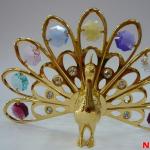Your attention is invited to another indicator of the output voltage for the power amplifier. This indicator is assembled on the ATMEGA8 microcontroller. In it, to indicate the signal level, two lines of 33 LEDs, or rather of 32, are used, since the first two LEDs in two channels are constantly lit to indicate the beginning of the scale (or at least some kind of indication in the absence of a signal). If desired, they can not be installed. The indicator can work in linear and logarithmic modes of displaying the signal level, also the indication can be a line or a point with displaying peak signal levels and without displaying peak levels. The indicator allows you to select these operating modes in any combination:
- Linear or logarithmic level conversion.
- Display the current level as a column or dot.
- Turns the peak level display on or off.
Picture 1.
Assembled indicator.
Details.
The VU-meter was taken as the basis for this indicator circuit, where there was only one mode of operation and without indication of peak signal levels. Mikhail Sergeev slightly changed the initial scheme of the indicator to increase its reliability and expand the functionality of the device. In particular, a three-position Dip-switch was added to select the required display modes, and current-limiting resistors were added. The program for the new scheme with advanced features was written by Nikolai Egorov.
Figure 2.
Indicator scheme.
The indicator circuit is assembled on an ATmega8 microcontroller.
The input signal is fed to the inputs of the microcontroller through limiting resistors RxL And RxR. Without them, with a strong signal from the amplifier (when the indicator is connected to the output of the power amplifier), the microcontroller may be damaged.
The indicator uses dynamic indication. All indicator LEDs - form four sections of 16 LEDs (the first two are constantly on). To increase the brightness of the LEDs, the sections are switched on with keys on BC337 transistors, instead of which you can use any average power of the corresponding structure. It was also noticed that when the transistors are closed, there is a slight illumination of the sensitive LEDs of the off sections. Therefore, resistors were installed to eliminate this phenomenon. R10-R13(470 ohms). These resistors initially can not be installed on the board if there is no illumination.
The ATmega8 microcontroller has a limit on the total current flowing through any power pin, which is 300 mA. The maximum current through any other output must not exceed 40 mA. Therefore, the current through one LED should not exceed 15-18 mA. This must be taken into account when selecting limiting resistors in LED circuits. For LEDs with an operating voltage of 2.5 volts, the resistance of the limiting resistors should not be less than 110 ohms.
The resistance of the limiting resistors for the LEDs used in the circuit can be calculated using the following formula;
R=(Udd - Ut - Uled)/Imax
Udd - voltage after the stabilizer, 5 volts
Ut - voltage drop across the open key, approximately 0.5 volts
Uled - LED nominal voltage
Imax - maximum LED current, but not more than 18 mA
The choice of the required operating mode of the indicator is carried out by DIP-switches SW1-SW3, in the absence of which you can use jumpers switched by jumpers.
The program is designed to operate the microcontroller from an internal RC generator with a frequency of 1 MHz, so changing the factory fuses of the microcontroller during programming is not required.
It is best to connect the indicator to the output of the preamplifier so that the volume and tone controls do not affect the indication. To ignite all the LEDs, a signal of 2 volts must be applied to the indicator input. If your preamplifier does not provide the required signal level at the input of the indicator, then its input part (indicator) must be supplemented with additional amplifiers (one LM358 case) according to the following scheme (one channel is shown).

Figure 3
preamplifier.
In general, the design is not critical to the choice of parts. Fixed resistors can be of any power. SMD resistors can also be used as limiting resistors, and resistors connected to DIP switches, for which contact pads are provided on the printed circuit board. At the same time, holes for installing conventional resistors that are installed vertically in these places can not be drilled.
When selecting replacement transistors, it is necessary to take into account the maximum collector current, which must be at least 300 mA. Diodes - any low-power, with a reverse voltage not less than the amplitude of the voltage output by the amplifier at maximum power.
Figure 4
Indicator printed circuit board.
The indicator is assembled on a printed circuit board, 100x70 mm in size. The LEDs for the indicator are flat and they are installed on the board close to each other with a wide side.
Yes, in order for the lit LEDs not to light up the adjacent ones with their glow, it is advisable to lay a reflective material between them, for example, pieces of food-grade aluminum foil.
You can resize as you wish. printed circuit board, both in length and width, for example, using round LEDs (the length of the board will naturally increase), or put flat LEDs with a narrow side to each other.

Figure 5
LED matrix.
In the design, you can also use LED matrices, similar to these or smaller (10 LEDs each). There is no illumination of neighboring LEDs in such matrices.
Stabilizer 7805, mounted on a small heatsink.
Watch a demo video of your implementation of this indicator scheme by Mikhail Sergeev. A peculiar design solution and during operation a linear display mode was selected, with an indication of the peak level.
Video.
The attached archive contains all the necessary files for assembling the indicator.
Archive for article
DIY do-it-yourself stereo signal peak indication block, simple peak indicator circuit. Peak indicators of audio signals show the fact that the level of the AF signal exceeds a certain predetermined value.
Here is a description of the peak LED indicator based on the CD4093 chip. The domestic analogue of which is K561TL1. The microcircuit contains four logic elements "2I-Not" with the effect of Schmitt triggers. In this circuit, the inputs of each of the elements are interconnected, so the elements work as inverters - Schmitt triggers.
circuit diagram
The output signals of the stereo channels from the ULF output are fed through the capacitors C1 and C2 to the inputs of the elements D1.1 and D1.2, respectively. The inputs of these elements through the resistors R2 and R3 receive a constant bias voltage from the tuning resistor R1.
At the inputs of the logic elements, the DC offset voltage is added to the variable component of the audio signal. The task of the resistor R1 is to set the optimal bias voltage, at which the necessary sensitivity of the indicator will be, that is, this peak threshold is set by this resistor.
Rice. 1. circuit diagram homemade peak indicator.
The state at the outputs of elements D1.1 and D1.2 will change only when this threshold is exceeded, this circuit is set to be converted into logic level pulses, which charge capacitors C3 and C4 through diodes VD1 and VD2. These circuits of diodes VD1, VD2, capacitors C3, C4 and resistors R4, R6 work as detectors.
And the voltage across capacitors C3 and C4 increases. This is especially important, since the peak moment of the input signal may not be long. And the voltage is held in the form of charge by these capacitors because they quickly charge through the diodes and slowly discharge through the resistors.
As soon as the voltage on C3 or C4 reaches the switching threshold of the Schmitt trigger (D1.3 or D1.4, respectively), a logic zero appears at the output of D1.3 or D1.4, which leads to the lighting of the HL1 or HL2 LED. The corresponding LED, or if the stereo signal is well balanced, both LEDs flash and light for at least the time required to discharge C3 or C4 through R4 or R6.
Details and setup
LEDs - any indicator, for example, AL307. Establishment - by adjusting the resistor R1 according to the threshold.
LM3915 - an integrated circuit (IC) manufactured by Texas Instruments, responds to a change in the input signal and outputs a signal to one or more of its outputs. Thanks to its design feature, IC has become widespread in LED indicator circuits. Since the LM3915 based LED indicator works on a logarithmic scale, it has found practical application in displaying and monitoring the signal level in audio amplifiers.
Do not confuse the LM3915 with its relatives LM3914 and LM3916, which have a similar layout and pinout. The 3914 series IC has a linear characteristic and is ideal for measuring linear quantities (current, voltage), while the 3916 series IC is more versatile and is able to control various types of loads.
Brief description of LM3915
The block diagram of the LM3915 consists of ten of the same type of operational amplifiers operating on the principle of a comparator. The direct inputs of the op-amp are connected through a chain of resistive dividers with different resistance values. Due to this, the LEDs in the load light up according to a logarithmic dependence. The input signal comes to the inverse inputs, which is processed by the buffer op-amp (pin 5).
The internal device of the IC includes a low-power integrated stabilizer connected to pins 3, 7, 8 and a device for setting the glow mode (pin 9). The supply voltage range is 3–25V. The value of the reference voltage can be set in the range from 1.2 to 12V using external resistors. The entire scale corresponds to a signal level of 30 dB in 3 dB steps. The output current can be set from 1 to 30 mA.
Scheme of the sound indicator and the principle of its operation
 As can be seen from the figure, the main circuit diagram sound level indicator consists of two capacitors, nine resistors and a microcircuit, the load for which is ten LEDs. For the convenience of connecting power and audio signal, it can be supplemented with two solder connectors. To assemble such a simple device is within the power of any, even a beginner, radio amateur.
As can be seen from the figure, the main circuit diagram sound level indicator consists of two capacitors, nine resistors and a microcircuit, the load for which is ten LEDs. For the convenience of connecting power and audio signal, it can be supplemented with two solder connectors. To assemble such a simple device is within the power of any, even a beginner, radio amateur.
A typical inclusion provides power from a 12V source, which is supplied to the third output of the LM3915. It, through the current-limiting resistor R2 and two filter capacitors C1 and C2, goes to the LEDs. Resistors R1 and R8 serve to reduce the brightness of the last two red LEDs and are optional. 12V also comes to the jumper that controls the operating mode of the IC through pin 9. In the open state, the circuit operates in the "point" mode, i.e. there is a glow of one LED corresponding to the input signal. Closing the jumper puts the circuit into "column" mode, when the input signal level is proportional to the height of the luminous column.
The resistive divider assembled on R3, R4 and R7 limits the input signal level. More precise tuning is carried out by a multi-turn tuning resistor R4. Resistor R9 sets the offset for the high level (pin 6), the exact value of which is determined by the resistance R6. The lower level (pin 4) is connected to the common wire. Resistor R5 (pin 7.8) increases the value of the reference voltage and affects the brightness of the LEDs. It is R5 that sets the current through the LEDs and is calculated by the formula:
R5 \u003d 12.5 / I LED, where I LED is the current of one LED, A.
The sound level indicator works as follows. At the moment when the input signal overcomes the low level threshold plus the resistance at the direct input of the first comparator, the first LED will light up (pin 1). A further increase in the sound signal will lead to the sequential operation of the comparators, which will let you know the corresponding LED. To avoid overheating of the IC case, the LED current should not exceed 20 mA. Still, this is an indicator, not a New Year's garland.
PCB and Assembly Parts
 The printed circuit board of the sound level indicator in lay format can be downloaded. It has dimensions of 65×28 mm. Assembly requires precision parts. Resistors type MLT-0.125W:
The printed circuit board of the sound level indicator in lay format can be downloaded. It has dimensions of 65×28 mm. Assembly requires precision parts. Resistors type MLT-0.125W:
- R1, R5 R8 - 1 kOhm;
- R2 - 100 Ohm;
- R3 - 10 kOhm;
- R4 - 50 kOhm, any tuning;
- R6 - 560 Ohm;
- R7 - 10 Ohm;
- R9 - 20 kOhm.
Capacitors C1, C2 - 0.1 uF. It is recommended to solder the LM3915 IC not directly, but through a special socket for the microcircuit. In the load, you can use ultra-bright LEDs of any glow color, up to purple. But this is a personal aesthetic preference. To display a stereo signal, you will need two identical boards with independent inputs. More details about LM3915 can be found in technical description Here.
The performance of this indicator has been proven in practice by many amateur radio clubs and is still available in the form of MasterKit sets.
Read also
Audio indicator on AN6884 |
The basis of the design is two microassemblies of the AN6884 (KA2284) type, this is a ready-made LED signal level indicator used to indicate various values \u200b\u200bof the variable signal, to which it remains to connect a few piping components and the LEDs themselves. The scheme of such a device is just shown in the figure below.

You can see photos of the assembled and soldered printed circuit board in the figure below, and you can take its drawing made in the Sprint Layout program from the green link above.

The basis of the design of operational amplifiers - LM324. This circuit uses two quad op-amps to form eight audio frequency slave channels.

Another interesting version of the circuit of 10 LM324 chips and 40 LEDs. If you assemble two identical designs, you can use it in stereo mode. Supply voltage 12 V, current consumption 2.5A
The range of the sound level indicator (ULF power) should be in the range from 0.5 to 50 watts. A feature of the device is that it does not require an external power supply, it receives its volts from the incoming audio signal.
The basis of the circuit is the LM339 chip, which is a quad comparator. The voltage going to the input of the indicator is doubled with the help of diodes VD1 and VD2 and capacitances C1 and C2, then it follows the 78L05 stabilizer used to power the LM339 op amp and the inverse inputs of the comparators through a voltage divider on resistors R6 and R7. With the help of trimmers R2-R5, each comparator is adjusted to operate at any required level. When the comparator is triggered, the corresponding LED lights up.

LED sound indicator on the A227D chip (K1003PP1) |
Basic device settings
Circuit supply voltage: 10-18 V
Input voltage at terminals 3,16,17, max 6.2 V
U input 50-500 mV

Resistance R6 adjust the brightness of the LEDs. Resistor R8 sets the level of lighting of the first LED. R10 - too, only for the last LED. The integrating chain R4,C3 sets the delay time for turning off the LEDs.
The basis of a simple design is the AN6884 chip, which is an almost ready-made signal level indicator. You can also use the transistor version of the device, but you will need a lot of transistors and the effect will be an order of magnitude worse, and the sensitivity is generally lower.
New Year's holidays have given the chance to get back a little to have a rest.
For me, the best rest is to make some new light toy.
I hope it will be as interesting for you as it is for me.
Having in the presence of certain developments, the design of the weekend turned out.
The highlight of the design is its amazing simplicity!
The analysis of sound and the construction of effects is entrusted to the program.
Data transfer goes to a very common controller via USB, from there it receives power.
And the effect turned out to be quite dynamic and spectacular: just remember "Cat's Eye"!
Minimum parts, simple single-sided board and no setup!
The scheme and firmware of the iron is taken from the article "Dynamic Lighting Installation for Winamp".
The circuit is simplified according to the Chinese format - "unnecessary" current limiting resistors are thrown out. Works!!!
And if in doubt, put resistors, I warned you!

Slightly tweaked the firmware to be defined as a VU meter USB device:

And he laid out a new printed circuit board:


2 gadgets were assembled to indicate the level of the left and right channels.

Of course, it would be possible to assemble a stereo indicator on one Mega-8 based on the "Cat's Eye" and get 2x9 channels.
But there is one "BUT" - to smash the left and right side in space will not be so simple and aesthetically pleasing. Well, where can I get 2 additional USB port?
Buy an expansion board or a hub! I already have 2 such boards with 5 ports on my computer, plus 10 on board - a total of 20 ports, but you don’t need to poke anything !!!
And finally, a program has been written to control this disgrace.
For me, this is the most interesting part of the work!

The program was written in your favorite studio on the equally beloved VBNET, although in Lately I write more and more in C#.
She, as always, has the ability to hide in the tray and register in autoload. And the dynamic icon, beloved by everyone according to previous designs, not only duplicates real LEDs, but also shows the presence of the connection of the left and right channels. 12 different level display options will be able to find their audience. Involved in the management of not only the number of LEDs on, but also their brightness. This made them very spectacular! I think that over time it will be possible to add more effects. The program has been tested on XP/32 and 7/64. I wonder if it will work on newer versions? Looking forward to your testing!
Thank you all for your generosity and all possible help!
Share information on your finished devices, send your suggestions for improvement!




















